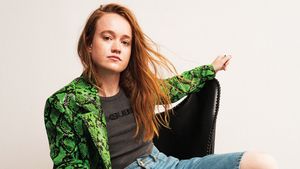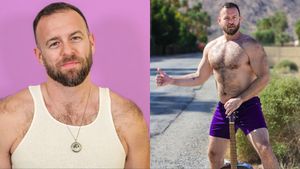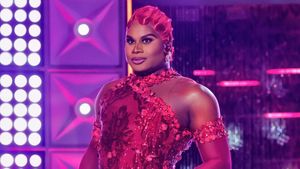Every year since 2010, the Kinsey Institute (named for Dr. Alfred Kinsey, the bisexual sexologist who also lent his name to the Kinsey Scale) has the Singles in America (SIA) Study. The independent study is sponsored by none other than match.com, a company that certainly has some interest in figuring out what single Americans are feeling.
One of the most interesting trends over the past decade and a half is the rise of people engaging in or willing to engage in "consensual non-monogamy," which the American Psychological Association defines as, "an umbrella term for relationships in which all partners give explicit consent to engage in romantic, intimate, and/or sexual relationships with multiple people." According to the 2023 SIA Study, nearly a third (31%) of singles reported having been in a non-monogamous relationship.
Queer isn't just something you are, it's something you do. LGBTQ+ folks have been queering dating norms for as long as we've been around. For many, this rise in CNM sounds like a breath of fresh air; a sign that progress is still being made all the time, little by little. For others, this induces a cold sweat — it's you, you are "others" in this case. You're partner has suggested opening your relationship and you don't want to, so you panicked and went to the internet for advice and now you're here.
So what do you do if you've found your one and only, but they want to keep looking? One person's "progress" is another person's "nightmare!" And if — and that's a really big if— you do try CNM, you might be completely overwhelmed by the terms and different styles. Does this mean you should just break up?
However your feeling right now just know it's valid. So, we gathered three queer relationship experts, Ally Iseman, writer, television host, relationship coach, and founder of the educational platform passport2pleasure.com; Anne-Marie Zanzal, ordained minister, late-in-life lesbian, coming out coach, and founder of Anne-Marie Zanzal Coaching; and Melissa Klass, a licensed marriage and family therapist, to help you figure out where to go from here.
Does my partner wanting an open relationship mean I'm doing something wrong or not doing enough?

Courtesy of Tirachard Kumtanom/Shutterstock
"When a partner suggests opening a relationship, it’s common to be concerned that you are not enough, that you’ve done something wrong, or perhaps you aren’t doing something that the other person may want or need from you," says Klass. "In my experience, desire for non-monogamy is rarely about inadequacy. Monogamous relationships are founded on the cultural and societal belief that one person can — and should — be your everything. This is an immense amount of pressure for one to fulfill. The desire to explore non-monogamy can be about novelty, sure, but more often is about meeting a need that it may be difficult or even unreasonable for a current partner to fulfill."
I myself am in an open relationship, and one of the most helpful practices for me personally has been getting very good at looking at situations and telling myself, "This is not about you." Zanzal reaffirms this concept, saying, "This is about their needs and desires. I would be leery if my partner stated they wanted an open relationship because of something I did or didn't do. That feels like them evading the responsibility of wanting an open relationship. People often open relationships because one or both the partners want to explore other romantic opportunities. Or one partner no longer wants to be sexually intimate."
The approach to an open relationship, Iseman describes, should be "A 'yes and' rather than an 'either or' decision. This means that it's intended as an additive experience to an already secure dynamic as opposed to a solution to or escape from addressing something difficult. It can be a perfectly reasonable solution to some relationship incompatibilities, but only if the issue has already been directly addressed and examined so that opening up is not used as an avoidance tactic."
Your own adequacy and place in your partner's life isn't a factor, and you have to find assurance of your own worth in your relationship, non-monogamous or not. As Iseman so succinctly puts it, "Enoughness is not necessarily what's on the table here."
Not all open relationships look the same, what are some options for exploring nonmonogamy?

Courtesy of Clara Mucia/Shutterstock
Okay, so even if you're not in love with the idea, it's worthwhile to at least be on the same page with your partner. There are plenty of configurations for CNM, so you should figure out what they mean when they say they want to open the relationship. We have a brief introduction to some common forms of CNM to help you wrap your head around it.
Klass outlines the basics well. She defines some key terms like, polyamory as, "building meaningful relationships with multiple partners, where love and commitment are shared." Iseman expands on polyamory, adding, "You can have an open or closed polyamorous dynamic, ie: you can have a closed polyamorous relationship with two other people but you all only engage sexually and emotionally within the triad dynamic and are closed to connections outside of that."
Your partner might be someone who is finding that being non-monogamous is an important part of their identity, something essential. Or, they might be "ambiamorous, meaning they are equally happy and fulfilled in either a monogamous or non-monogamous dynamic," says Iseman.
There's also the idea of being "monogamish," which Klass defines as, "staying primarily monogamous but allowing occasional outside experiences," like allowing your partner a "hall pass."
All this is key to building a healthy relationship, whatever you and your partner decide. "Understanding more fully all the options that are actually available enables you to actually choose your relationship, even if you choose monogamy," says Iseman.
Though you shouldn't overwhelm yourself, it's a lot to take it. Once you feel like you've got the absolute basics down an you're ready for terms like "Swinging or Swapping, Hierarchical or Non-Hierarchical Polyamory, Solo Poly, and Relationship Anarchy," then Iseman's course "ENM 101: Exploring Healthy Non-Monogamy" is an excellent resource.
What are some green flags in my relationship that, if we did open up, show we're ready for it?

Courtesy of Lomb/Shutterstock
If you end up in a place where you feel you might want to at least try an open relationship, the hard part then becomes trying to do self assessment on whether or not you can handle it. Like many of life's big decisions, sometimes you'll never know if you're ready to do it until you do it. But! That doesn't mean you can't make an informed decision! Here are some indicators that bode well for opening up a relationship.
Klass keeps it simple, saying that you and your partner need a baseline of, "Clear, compassionate, and specific communication," "baseline trust," "strong sense of self" and "a shared curiosity." Great news: those are all qualities to be fostering in a relationship for any reason, and there's a reason that they keep coming up again and again.
"You trust each other and that the relationship between the two of you is first and foremost," says Zanzal, also adding, "Both parties feel secure in this relationship and have no fears around abandonment of replacement." She brings up that it can be helpful if you and your partner just aren't naturally drawn to envy, saying when "both parties are genuinely happy for each other's experiences and there is no jealousy" that's a huge green flag.
Iseman brings up the term for this: compersion. "Commonly referred to as 'the opposite of jealousy,' is when you feel joy or pleasure from your partner experiencing joy or pleasure with someone else," she says.
These are all traits that can be learned, grown, and developed, but if you're naturally inclined to them or they're already something you've been trying to build between each other, that'll make the concept of a successful open relationship much more realistic.
What are some signs that might mean we should wait, or not be right for opening up at all?

Courtesy of engagestock/Shutterstock
Inversely, as much as your partner an open relationship, you might be opposed to it because it's not a good idea for you two right now. Maybe they have some blind spots to qualities of your relationship that could make opening it up a bad idea from the get go. If you're struggling with any of these things, bring them up with your partner, you should both be making as informed of a decision as possible, whatever it is. Klass says simply, "Non-monogamy tends to amplify any existing challenges within a relationship. If there’s unresolved tension or unmet needs, those issues will likely become more pronounced."
When evaluating the concept of having an open relationship, your partner should explain in detail what it is they're looking for and you both need to be self-aware of the problems you've shared together. "If the relationship has been monogamous up to this point and you are using an open relationship to 'save' it," is a massive red flag according to Zanzal.
She asks, "Are you using an open relationship to avoid addressing concerns about the relationship? One partner feeling pressured or coerced and allows the open marriage to make the other partner happy, this indicates an imbalance of power in the relationship. If either of you has problems with boundaries in any aspect of your life, then the boundaries of an open relationship may be too difficult for you. Are you prone to jealously or insecurity? This is a red flag not to open up your relationship. Poor communication, dishonesty, or secretive behavior can undermine trust, while emotional or physical neglect may leave one partner feeling disconnected."
"Avoiding discomfort is a solid sign that you are not ready to open up your relationship. This can look like requiring 'veto power' over your partner's potential other partners or enacting a DADT (Don't Ask Don't Tell) policy. These are often used to mask cheating and/or avoid uncomfortable experiences like jealousy or mistakes," says Iseman. You can't experience compersion just by running away from jealousy. "Uncomfortable is not the same thing as unsafe, and it is a requirement for growth. Not being radically honest and authentic in your communication or being unwilling to accept responsibility for when you aren't is another red flag. If you say one thing but mean another — aka 'testing' your partner— you are not ready to open up. It's okay to think you will be okay with something and then after the fact realize you're not, but it's not okay to blame your partner for acting within an agreement you made even if it makes you uncomfortable."
Is it harder for queer women to open their relationships vs. straight couples or queer men?

Courtesy of MandriaPix/Shutterstock
While there are wide overlaps in queer culture, this is one area where queer women and queer men differ vastly. "Gay men are often assumed to be sexually non-monogamous (polysexual) unless otherwise discussed, whereas queer women generally engage more readily with emotional connection (polyamorous)," says Iseman.
"Queer women’s relationships often carry unique cultural baggage," says Klass. "Cultural baggage like, 'The 'U-Haul' stereotype of intense emotional intimacy can make the idea of 'sharing' feel especially daunting. Additionally, the queer community is smaller and more interconnected, which means the boundaries between friends, exes, and lovers can blur. Queer women are also navigating societal narratives that say they should feel lucky to have any partner, let alone one who accepts them as they are. Opening a relationship can feel risky when the world already tells you that love is scarce."
As progressive as we queers would all like to think of ourselves, we're all products of our culture for better or worse. "Queer women as a subculture do not have many examples of healthy, loving, stable open relationships, and therefor it's hard to envision one for yourself. "Just like comphet [compulsive heterosexuality] there are internalized monogamy norms where all of us must be in a committed monogamous relationship," describes Zanzal. Not to mention, "Queer women take an enormous risk already rejecting the patriarchal structures, so further rejecting monogamy may be too much for some people."
What do I do if neither of us changes how we feel about an open relationship?

Courtesy of PeopleImages.com - Yuri A/Shutterstock
Even with all your knowledge, and know how, even if you have all the green flags a relationship could wish for, you might still end up at a stalemate. At the end of the day, you might be staring down a very cold, hard truth: that you are in a wonderful relationship, but you want to be monogamous and your partner no longer does. Neither of you have done something wrong in honestly recognizing and holding steadfast to your own needs. But it might be time for someone to say the hard part.
"Explore whether or not you can meet your partner’s needs without sacrificing your own. If the answer is no, then the most loving choice might be to let each other go. It’s not a failure; it’s an acknowledgment that love isn’t just about compatibility but also alignment in vision," says Klass.
"It may be time to consider ending the relationship," agrees Zanzal. "Although painful, it is less painful then being in a relationship that you do not want or are uncomfortable in. Your needs and desires are important too."
Iseman suggests another option, adding, "You also don't both have to be non-monogamous to open up. Mono-Poly relationships are possible, but come with their unique challenges and benefits. Working with a vetted and experienced professional to navigate this decision making process and guide you in any exploration can make the difference between a hard or soft landing."
Whatever you decide, wherever you end up, Klass say to, "Approach it with compassion, curiosity, and care. Whatever you decide, you’ll learn more about yourself and each other — and isn’t that the heart of any great love story?"
Experts cited:
Ally Iseman, writer, television host, relationship coach, and founder of the educational platform passport2pleasure.com.
Anne-Marie Zanzal, ordained minister, late-in-life lesbian, coming out coach, and founder of Anne-Marie Zanzal Coaching.
Melissa Klass, licensed marriage and family therapist offering remote therapy throughout California with extensive experience working with diverse relationship configurations, including ENM and CNM.




































































































































